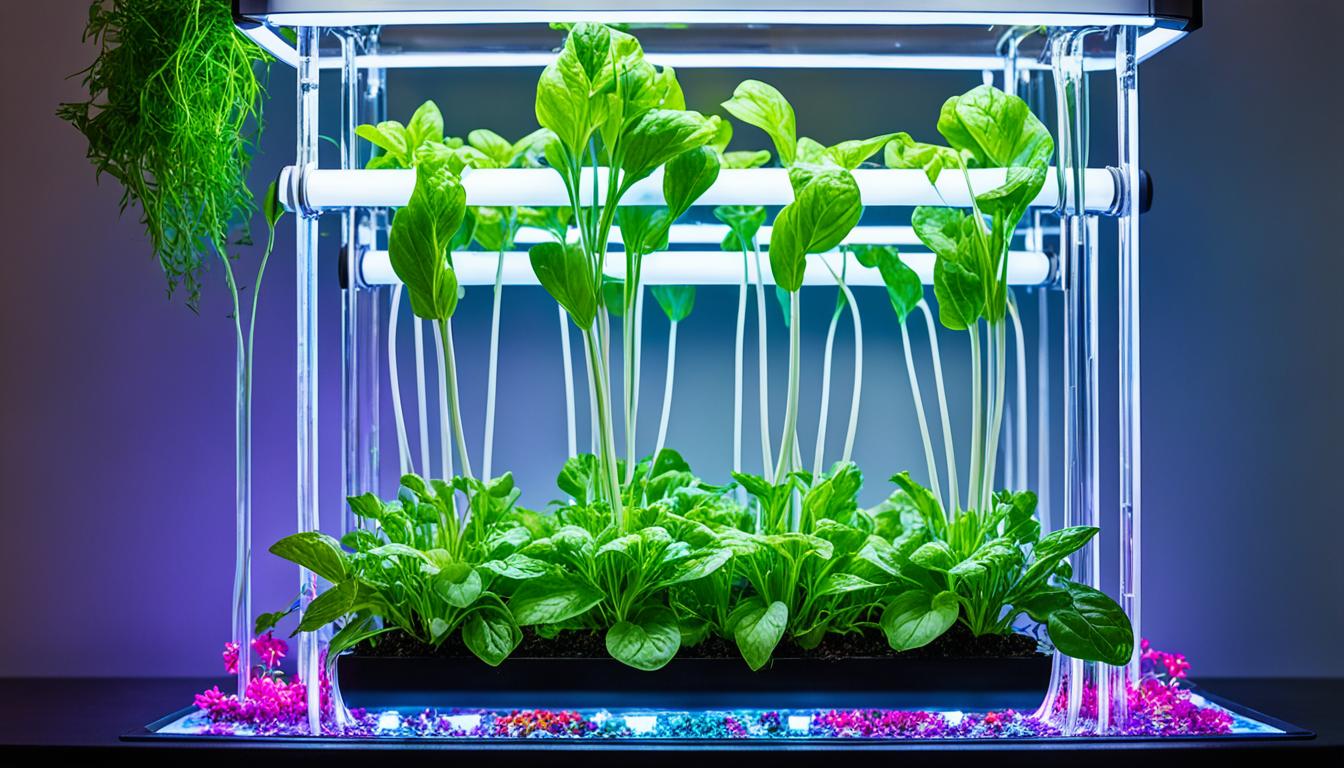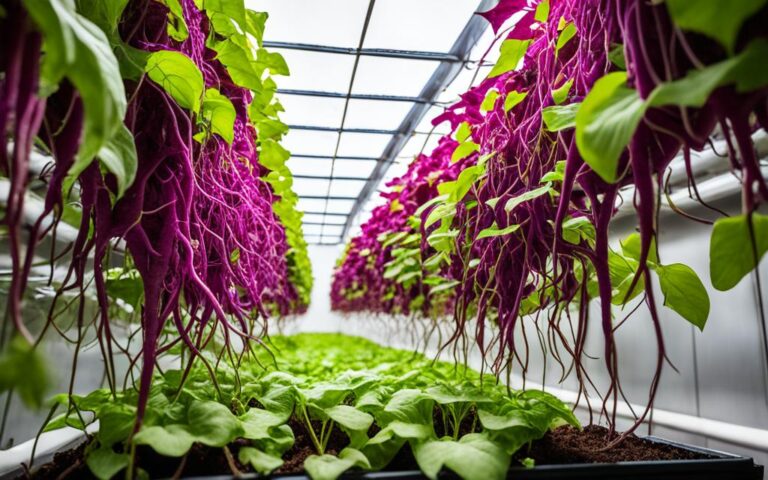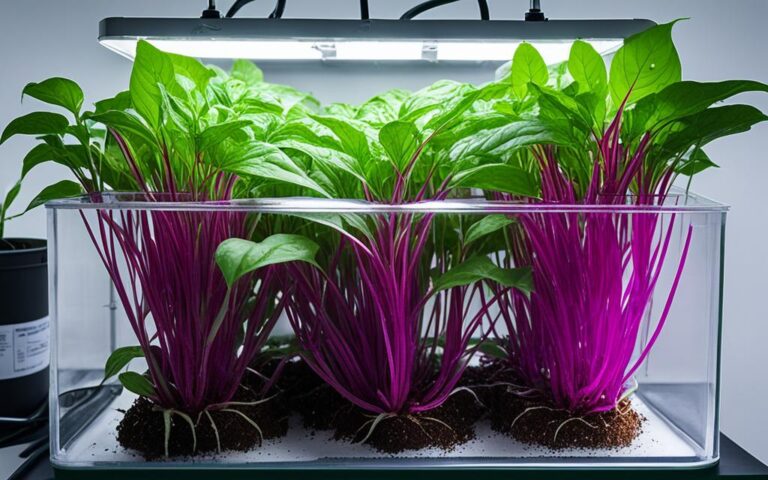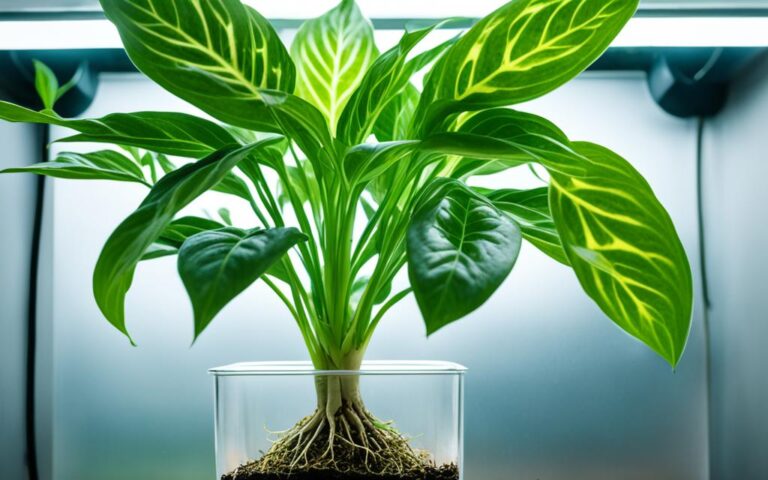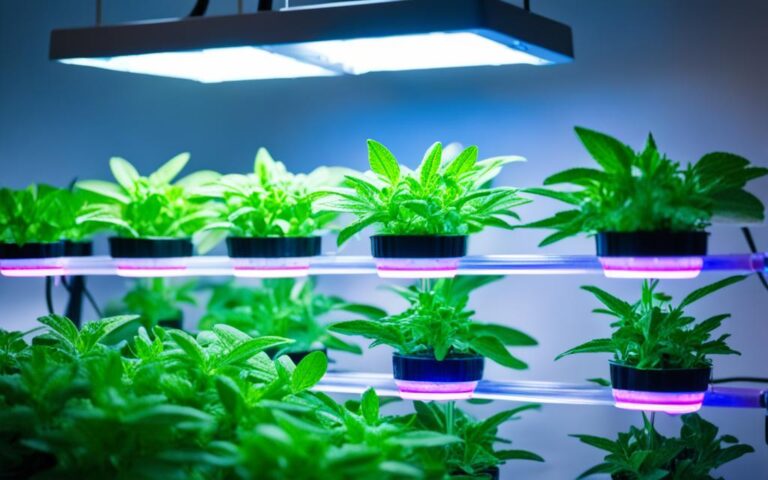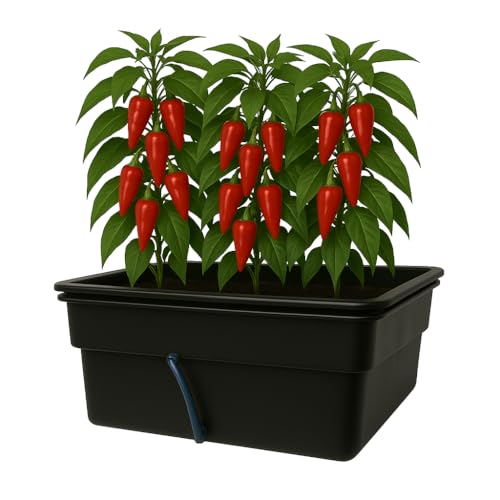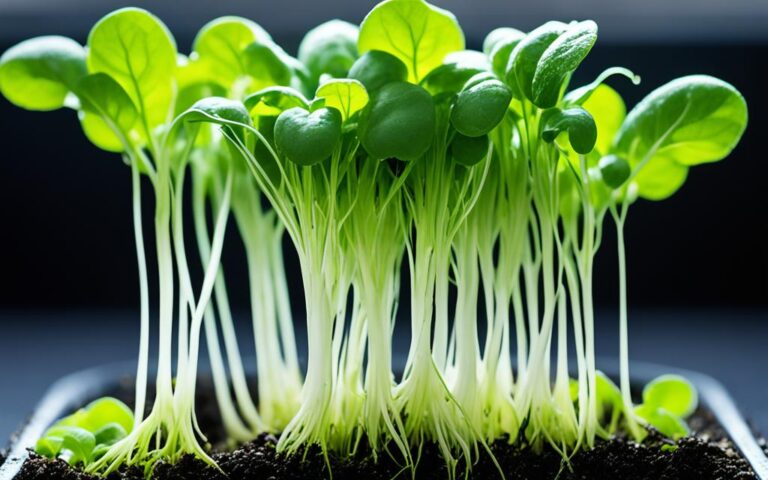Growing Hydroponic Flowers: A Modern Gardening Approach
Hydroponics is a new way of gardening that brings many benefits. It’s perfect for both experienced gardeners and beginners. By starting a hydroponic garden, you open up a world of new possibilities. We’ll cover the basics of hydroponics and give you tips on setting up your own system at home.
Key Takeaways
- Hydroponic gardening uses 90% less water than traditional agriculture, making it a highly efficient and sustainable method.
- Hydroponic systems accelerate plant growth, allowing for faster maturation compared to soil-based cultivation.
- Reverse osmosis water, commonly used in hydroponics, eliminates 98% of impurities, ensuring plants receive optimal nutrients.
- Hydroponic flowers can be pesticide-free, producing healthier and higher-quality blooms.
- Hydroponics is utilized by small farmers, hobbyists, and commercial enterprises for a wide range of crops, including ornamental flowers.
Table of Contents
Introduction to Hydroponic Gardening
Hydroponic gardening is a new way to grow plants without soil. It uses nutrient-rich water to feed the plants. This method is different from traditional gardening because it uses mediums like perlite or coconut coir instead of soil.
This lets gardeners control things like nutrient levels and water supply. It’s a way to make sure plants get exactly what they need to grow well.
What is Hydroponics?
Hydroponics is a soil-less way to grow plants. Plants get their nutrients from water instead of soil. This method helps plants grow faster and produce more than traditional gardening.
Hydroponic systems create the perfect environment for plants. They make sure plants get the right nutrients and protect them from pests and diseases.
Benefits of Hydroponic Gardening
Hydroponic gardening has many benefits. It’s popular with both home gardeners and big growers:
- Water Conservation: Hydroponics uses up to 90% less water than traditional gardening.
- Reduced Pest and Disease Risks: Hydroponics keeps pests and diseases away, cutting down on chemicals.
- Increased Yield and Growth Rate: Plants grow 25% faster and produce 30% more in hydroponics.
- Versatility and Space Efficiency: You can use hydroponics indoors or outdoors, growing many crops in small spaces.
By using hydroponic gardening, people can grow fresh produce all year. They can also try different soil-less cultivation methods that fit their needs.
Hydroponic Flower Varieties
Hydroponic gardening lets you grow many plants, including beautiful flowers. You can grow roses, lilies, orchids, tulips, and carnations in a controlled setting. These flowers love the nutrient-rich environment of hydroponics.
Best Hydroponic Flower Varieties
Marigolds are great for Nutrient Film Technique (NFT) systems. They are small, fragrant, and colorful. Orchids do well in passive systems with clay pebbles, just like their rainforest home.
Peace lilies are perfect for passive systems like wick pots. They need just the right amount of moisture and nutrients. Phlox grows well in large Dutch bucket systems because it likes moist soil and can get quite tall.
Roses are ideal for Deep Water Culture (DWC) systems. They need big beds and steady nutrients to grow well. Sunflowers also do great in NFT systems. They need lots of nutrients and support for their tall stems.
Other flowers like chrysanthemums, dahlias, petunias, and lavender also grow well in different hydroponic systems. This shows how versatile flowers can be in hydroponics.
Starting from Seeds vs. Transplants
Growers can start with seeds or transplants, based on what they prefer and know. Starting with seeds takes more time but can be rewarding. Transplants are quicker but still need care.
Hydroponics lets plants grow faster and produce more than soil gardening. It’s great for growing best hydroponic flower varieties from hydroponic flower seeds to hydroponic flower transplants. It’s perfect for soilless flower cultivation.
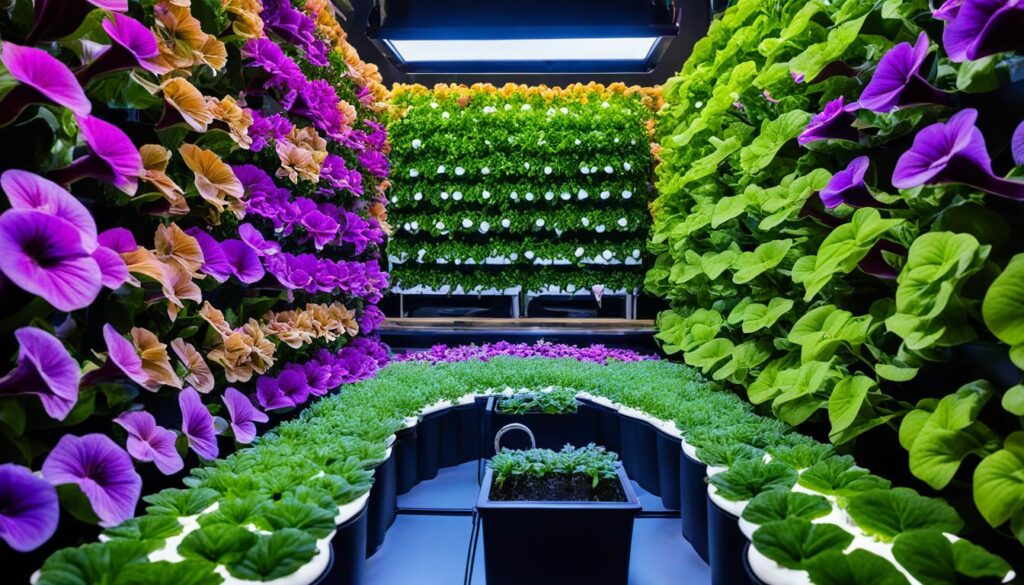
Setting Up Your Hydroponic System
Starting with hydroponic gardening means setting up carefully and getting the right gear. Hydroponics gives plants the nutrients they need right at their roots. It’s key to know the different systems and what you need for a successful garden.
Types of Hydroponic Systems
There are many hydroponic systems, each with its own way of working. Some popular ones are:
- Ebb and flow (flood and drain) system
- Deep water culture (DWC)
- Nutrient film technique (NFT)
- Aeroponics
- Drip irrigation
Each type of hydroponic system has its own benefits. It also needs certain equipment and materials to work well.
Essential Equipment and Materials
No matter the system, you need the right gear for a hydroponic garden. Here are some must-haves:
- Growing trays or containers
- Hydroponic growing mediums like perlite, coco coir, or hydroton
- Nutrient solutions with the right mix of nutrients
- Water pumps, air pumps, and air stones (for some setups)
- Plumbing stuff like tubing and fittings
- pH testing kits and ways to adjust pH
- Grow lights (for indoor soilless cultivation setup)
Picking the right hydroponic system and gathering all the parts is key. This way, you can grow lots of plants in a small space, using less water and land than traditional farming.
“Hydroponics allows us to grow a wider variety of plants in a smaller footprint, while using significantly less water and land than traditional soil-based agriculture.”
Nutrient Management for Hydroponic Flowers
Hydroponic flowers need a fine balance of nutrients to grow well. They require a mix of macro- and micronutrients for strong growth, beautiful blooms, and high yields. It’s important for growers to tailor nutrient solutions for their specific flower types.
Essential Nutrients for Flower Growth
Hydroponic flowers need 17 essential nutrients to thrive. The big ones, like nitrogen, phosphorus, and potassium, are needed in large amounts. The smaller ones, like iron and zinc, are needed in tiny amounts.
Macronutrients are key for things like leaf growth and flower formation. Micronutrients, though tiny, are also crucial. They help with metabolism, making chlorophyll, and enzymes.
Preparing Nutrient Solutions
Nutrient solutions for hydroponics have the right mix of nutrients. This includes big nutrients like nitrogen and smaller ones like iron. Growers can pick pre-made solutions or make their own by mixing fertilizers with water.
It’s important to keep the nutrient solution’s pH, TDS, and EC levels right. This ensures plants can use the nutrients well. The ideal pH for hydroponic flowers is between 5.0 and 6.5.
By watching and adjusting the nutrient solution, growers can make sure their flowers get what they need. This leads to strong growth, bright blooms, and lots of flowers.
“Proper nutrient management is the foundation of a successful hydroponic flower garden. By providing the right balance of essential elements, growers can unlock the full potential of their blooms.”
Environmental Factors for Hydroponic Flowers
The environment where hydroponic flowers grow is key to their health and growth. It’s important to get the light, temperature, and humidity right for them to thrive.
Light Requirements
Hydroponic flowers need extra light to grow well. Grow lights, especially LED ones, are great because they give the right light and use less energy. They help plants grow and bloom well.
What kind of light each hydroponic flower needs can vary. But most do well with a mix of natural and artificial light. It’s important to watch how much light your plants get as they grow.
Temperature and Humidity Control
Keeping the right temperature and humidity is key for hydroponic flowers. Most like a temperature of 65-75°F (18-24°C) and humidity of 50-70%. This helps them grow strong and bloom well.
By watching and adjusting the temperature and humidity for hydroponic flowers, growers can make the best environment. This supports healthy growth, flowering, and vigor.
“Providing the right environmental conditions is just as important as nutrient management when it comes to growing successful hydroponic flowers.”
Maintenance and Care
Keeping your hydroponic flower plants healthy is key for a big and lasting harvest. It’s important to watch over and care for your plants well. This helps your hydroponic garden stay strong.
Monitoring Plant Health
Watch your hydroponic flowers for pests, diseases, or not getting enough nutrients. Check the leaves, stems, and roots for any signs of trouble. Monitoring hydroponic flowers helps you fix problems fast and keep them healthy.
Pruning and Training Techniques
Using the right pruning and training techniques helps your hydroponic flowers grow better and look great. Cut off old flowers to make new ones grow. Use stakes or trellises for tall plants. Hydroponic flower maintenance with smart pruning and training makes your plants the best they can be.
“Proper maintenance and care are the keys to cultivating a thriving hydroponic flower garden.”
By always monitoring hydroponic flowers and using good pruning and training techniques, your plants will stay healthy and productive. Being careful and doing these things will give you lots of beautiful flowers for a long time.
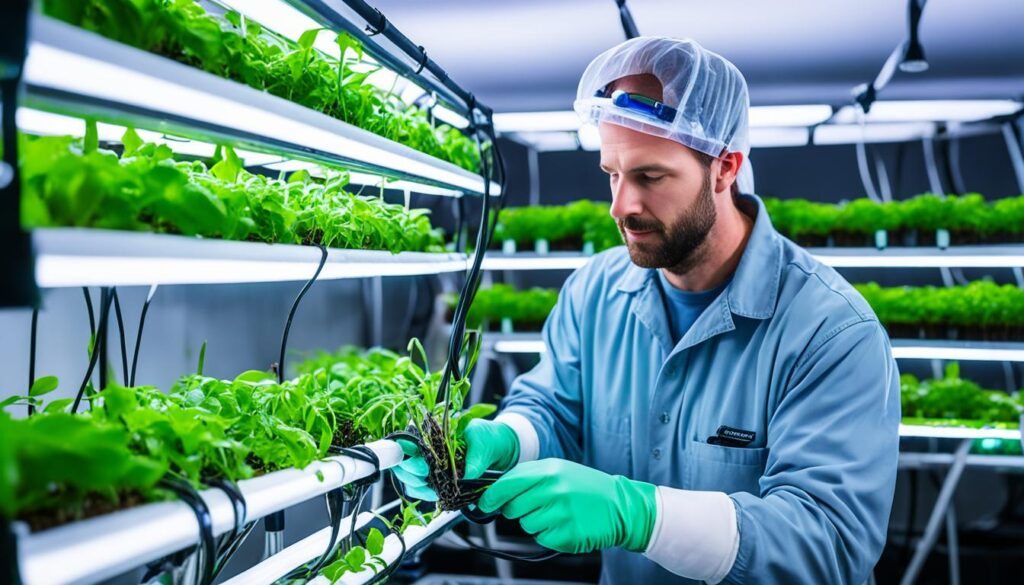
hydroponic Flowers
Hydroponic gardening lets you grow a wide variety of vibrant, long-lasting flowers. You can grow everything from classic favorites to exotic blooms. Hydroponic systems are perfect for many popular flower types to flourish.
Popular Hydroponic Flower Varieties
Some top hydroponic flower choices are:
- Hydroponic Roses: Roses are a timeless classic, and they look even better when grown hydroponically. With the right amount of water, nutrients, and the right temperature and air flow, hydroponic roses can have beautiful, long-lasting flowers.
- Hydroponic Tulips: Tulips are loved in spring, and hydroponics lets you enjoy their bright colors and elegant look all year. These flowers do great in the nutrient-rich, soil-free hydroponic setup.
- Hydroponic Orchids: Orchids are known for their exotic, beautiful flowers. Hydroponics gives them the perfect conditions to grow, making them a popular choice for both indoor and outdoor gardens.
- Hydroponic Lilies: Lilies, with their big, fragrant flowers, add beauty to any hydroponic garden. The controlled hydroponic environment helps lilies reach their full beauty, showing off their natural charm.
- Hydroponic Carnations: Carnations are a classic flower with a timeless beauty. They do well in the nutrient-rich, controlled conditions of a hydroponic setup, producing lots of beautiful flowers.
Choosing the right hydroponic flowers and giving them the care they need lets growers enjoy lots of beautiful, long-lasting blooms all year. This turns their living spaces into vibrant, nature-inspired places.
Common Issues and Troubleshooting
Growing hydroponic flowers has its challenges, but with the right steps, growers can fix pests, diseases, and nutrient issues. It’s key to keep an eye on your hydroponic flower garden’s health for lots of blooms.
Identifying and Treating Pests and Diseases
Growers might see pests like aphids, spider mites, and thrips. Using a mix of cultural, biological, and chemical controls can manage these pests well. Natural options like neem oil, garlic oil, and vinegar work great against pests.
Diseases such as powdery mildew, botrytis, and root rot can hit hydroponic flowers too. Keeping things clean, ensuring good air flow, and fixing nutrient imbalances can stop these diseases. If needed, use organic or chemical fungicides to fight them.
Addressing Nutrient Deficiencies
Nutrient issues are common in growing hydroponic flowers. Signs include yellow leaves, slow growth, and off-color blooms. Keeping an eye on the nutrient solution’s pH and EC levels is key for healthy plants. Fixing nutrient imbalances might mean changing the nutrient mix or flushing the system with the right water.
| Common Nutrient Deficiencies in Hydroponic Flowers | Symptoms | Recommended Treatments |
|---|---|---|
| Nitrogen (N) | Yellowing of older leaves, stunted growth | Increase nitrogen levels in nutrient solution |
| Phosphorus (P) | Reddish-purple leaves, poor root development | Increase phosphorus levels in nutrient solution |
| Potassium (K) | Leaf edges turning brown or scorched, slow growth | Increase potassium levels in nutrient solution |
| Iron (Fe) | Interveinal chlorosis (yellowing between leaf veins) | Add iron chelate supplement to nutrient solution |
By being alert and fixing problems fast, hydroponic flower growers can keep their gardens healthy and full of beautiful flowers.
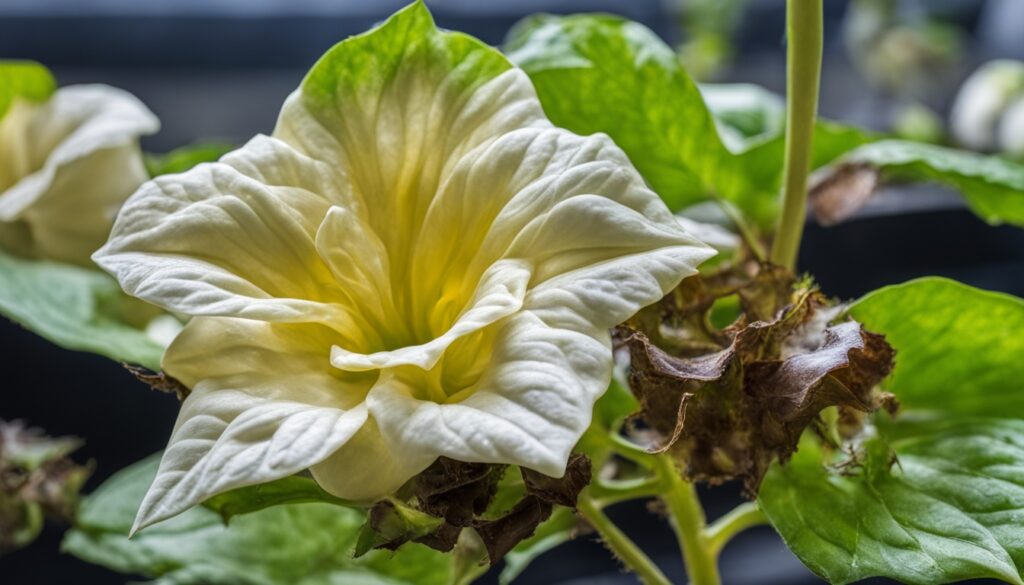
“Proper monitoring and timely troubleshooting are the keys to success in hydroponic flower cultivation.”
Harvesting and Enjoying Your Hydroponic Flowers
Growing hydroponic flowers lets you enjoy their beauty and scent all year. You can harvest them for special events or just to brighten your home. With the right techniques, you can make your flower harvests last longer.
For hydroponic flowers to last longer, harvest them correctly. Cut the stems at an angle to help them absorb water and nutrients. Be gentle with the blooms to prevent damage. Then, put them in clean, cool water right away.
Display your hydroponic flowers in vases, use them in arrangements, or give them as gifts. These blooms are vibrant and long-lasting, offering a unique gardening joy. Enjoy the act of harvesting hydroponic flowers and making beautiful displays that brighten your space and bring happiness to others.
Maximizing Flower Longevity
To keep your hydroponic flowers fresh and bright, follow these tips:
- Cut stems at an angle, about 1-2 inches above the plant base.
- Remove leaves that will be below water in the vase.
- Put the hydroponic flowers in clean, cool water right away.
- Change the water and trim the stems every few days to help them drink water.
- Keep your hydroponic flowers in a cool, bright spot, away from sunlight or heat.
Enjoying the Beauty of Hydroponic Flowers
There are many ways to enjoy your hydroponic flowers, like making beautiful arrangements or just putting them in vases. Use them to decorate your home, give them as gifts, or make special occasions even more special.
Fresh-cut hydroponic flowers are long-lasting and add beauty to any home. Growing and enjoying hydroponic flowers is a rewarding gardening experience.
| Hydroponic Flower Variety | Harvest Time | Vase Life |
|---|---|---|
| Roses | 3-4 months | 7-10 days |
| Lilies | 2-3 months | 5-7 days |
| Gerbera Daisies | 2-3 months | 7-10 days |
| Chrysanthemums | 3-4 months | 7-14 days |
Expanding Your Hydroponic Garden
As you get better at vertical gardening with hydroponic flowers, you might want to grow more. Using hydroponic flower towers is a great way to do this. These towers grow flowers in a way that saves space, often using walls or stacked levels. This lets you grow more flowers in a small area.
Growers can also look into automated hydroponic systems. These systems use technology to take care of things like water and nutrients. This means you can have a hands-off gardening experience as you expand your hydroponic flower gardens.
Vertical Gardening with Hydroponic Flowers
Vertical gardening with hydroponic flowers is a big step for those with limited space. It uses walls or stacked levels to grow many types of flowers in a small area. This method not only saves space but also looks beautiful and is efficient.
Automating Your Hydroponic System
As you get more into hydroponic gardening, you might want to automate your setup. Automated hydroponic systems can handle things like light and temperature for you. This automation makes it easier to expand your hydroponic flower gardens and saves time for other things.
| Feature | Benefit |
|---|---|
| Vertical Gardening | Maximizes growing space, creates a visually stunning display |
| Automated Hydroponic Systems | Reduces hands-on attention, streamlines the cultivation process |
Using vertical gardening with hydroponic flowers and automated hydroponic systems can really help you expand your hydroponic flower gardens. It makes growing more efficient and opens up new possibilities.
“Hydroponic gardening is considered by experts to be the future of food production due to its versatility in fitting into various environments and allowing un-farmable areas to grow nourishing food.”
Sustainable Practices in Hydroponic Gardening
Hydroponic gardening is a greener way to grow plants than traditional soil methods. By using sustainable hydroponic gardening methods, people can help make food production better for the planet.
Water Conservation
Water conservation in hydroponics is a big win. These systems use up to 90% less water than traditional gardens. This is because the water is reused, which is key as the world’s population grows and we need more food by 2050.
Reducing Waste and Pollution
Hydroponics also cuts down on waste and pollution in hydroponic systems. Growers use compostable materials and fewer chemicals. This makes hydroponics eco-friendly and supports a circular economy.
Sustainable hydroponic gardening offers more benefits. It can grow more food on less land and close to cities. This reduces transport emissions and gets food to us faster.
By adopting these green practices, hydroponic gardeners help solve big global issues. They make sure we have enough food, save water, and protect the environment. As our population grows, hydroponics will be key in feeding us without harming the planet.
Integrating Hydroponic Flowers into Your Home Decor
Hydroponic flowers are more than just a way to grow plants without soil. They can also make your home look amazing. Hydroponic flower systems fit well in many rooms, like kitchens, living rooms, and bedrooms. Some people even turn their walls into living walls or vertical hydroponic gardens, making their homes feel like green oases.
Adding hydroponic flowers to your home brings beauty, fragrance, and a connection to nature. Hydroponic gardening uses less water than traditional gardening. It’s important to change the water weekly to keep nutrients at the right level.
Plants like African violets and geraniums grow well in water and can make new roots. This makes them great for indoor flower gardening. Plants with strong stems and vines also grow well in water, offering more options for decorating your home.
Wall-hanging hydroponic gardens save space, and hydroponic vegetable and herb gardens let you grow food indoors with little mess. Plants like lettuce, basil, and radishes are perfect for these gardens.
The nutrient film technique is a great way to grow hydroponically for home decor. It keeps the water flowing with nutrients to the roots. The design of these gardens affects how well plants grow and bloom, sending energy directly to the plants.
Modern hydroponic containers are made for decorating homes, and hydroponic garden design ideas are popular in cities. Using plastic bottles for hydroponic garden design is also eco-friendly.
“Hydroponic gardening lets me create a lush oasis in my city apartment. The clean designs of these systems match my decor, and the flowers and herbs add natural beauty.”
Community and Resources for Hydroponic Gardeners
The popularity of hydroponic gardening is growing fast. This has created a strong hydroponic gardening community. This community offers lots of information, support, and inspiration for new and experienced gardeners. There are many resources like online forums, hydroponic gardening blogs, and hydroponic gardening workshops to help gardeners improve their skills and meet others who share their interests.
Online forums are a great place for hydroponic gardeners to share their stories, ask questions, and learn from each other. These forums are full of support and knowledge. They can help with everything from setting up a hydroponic system to fixing common problems. By joining these forums, gardeners can learn a lot from others and keep up with new trends in hydroponic gardening.
Hydroponic gardening blogs are also key resources for gardeners. They offer detailed guides, reviews of products, and stories from experienced gardeners. These blogs are great for both beginners and experienced hydroponic gardeners. They can help you learn more and improve your growing methods.
For those who prefer learning by doing, there are hydroponic gardening workshops and events in local areas. These cover many topics, from the basics of setting up a hydroponic system to advanced techniques for growing flowers. At these events, hydroponic gardeners can meet others, share their experiences, and learn new things to apply to their gardens.
Using these hydroponic gardening community resources, both new and experienced hydroponic flower growers can improve their skills, solve problems, and get inspired to grow their gardens even better.
“Hydroponic gardening has been a game-changer for me. The online forums and blogs have been invaluable in helping me navigate the learning curve, and the local workshops have allowed me to connect with a supportive community of fellow enthusiasts.”
Conclusion
Exploring hydroponic flowers opens up new possibilities for both experts and beginners. With hydroponics, you can grow a wide variety of beautiful flowers all year. You won’t need much space or worry about the weather. This guide has given you the key knowledge and tools for hydroponic flower cultivation.
By using these indoor gardening systems at home, you can enjoy your own hydroponic blooms. You’ll also help make our future more sustainable and self-sufficient in urban agriculture and horticultural technology. As the world’s population grows, soilless cultivation methods like hydroponics will be key in feeding everyone without harming the environment.
By following sustainable floriculture and botanical innovation, you can turn your space into a lush vertical farming garden. You’ll grow a variety of hydroponic flowers that will delight your senses. They’ll also encourage others to start gardening and care for the planet. Join the hydroponic gardeners movement and discover the endless possibilities of this exciting horticultural technology.
